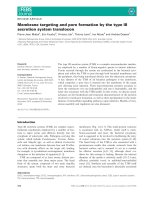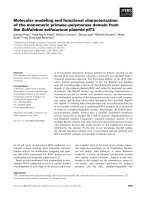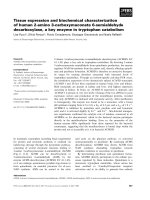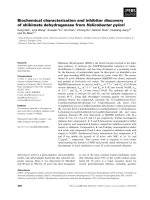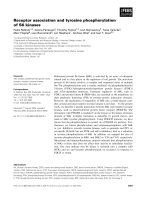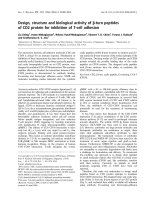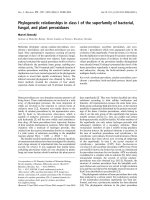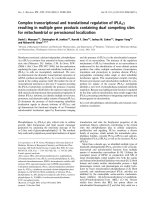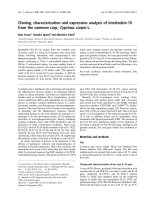Báo cáo khoa học: Structural aspects and biological properties of the cathelicidin PMAP-36 pot
Bạn đang xem bản rút gọn của tài liệu. Xem và tải ngay bản đầy đủ của tài liệu tại đây (279.94 KB, 9 trang )
Structural aspects and biological properties of the
cathelicidin PMAP-36
Marco Scocchi, Igor Zelezetsky, Monica Benincasa, Renato Gennaro, Andrea Mazzoli and
Alessandro Tossi
Department of Biochemistry, Biophysics and Macromolecular Chemistry, University of Trieste, Italy
A large number of gene encoded host defence peptides
(HDPs) has been described over the past two decades
(many are collected in the AMSDb database at http://
www.bbcm.units.it/tossi/antimic.html), and it has
become quite clear that they are used as a defence
mechanism throughout the living world [1–4]. Micro-
organisms use them to antagonize competitors [5,6],
plants and insects as the major effector molecules to
prevent and combat microbial infections [7,8], while
mammals use them to control commensal microorgan-
isms and as a first line of defence against invading
pathogens [9–11].
Several families of HDPs contribute to host defence
in mammals. Among them, a prominent role is played
by the cysteine-rich a- and b-defensins [10] and by sev-
eral other linear peptides belonging to the cathelicidins.
This family includes a large and quite diverse group
of HDPs, all deriving from propeptides with a well-
conserved N-terminal proregion [11] among which the
a- and b-defensins and cathelicidins play a prominent
role. Mammalian HDPs can have both a direct antimi-
crobial activity and ⁄ or act as immunomodulatory mole-
cules for cellular components of innate and adaptive
immune responses. In the former case, they are thought
to function principally at the level of bacterial mem-
branes, to which they are drawn by their cationic nat-
ure, and into which they can insert by preformed or
assumed amphipathic structures. These are based on
Keywords
antimicrobial peptide; cathelicidin;
homodimer; membrane permeabilization;
PMAP-36
Correspondence
M. Scocchi, Department of Biochemistry,
Biophysics and Macromolecular Chemistry,
University of Trieste, 34127 Trieste, Italy
Fax: +39 040558 3691
Tel: +39 040558 3990
E-mail:
(Received 29 April 2005, revised 24 June
2005, accepted 7 July 2005)
doi:10.1111/j.1742-4658.2005.04852.x
PMAP-36 is a cathelicidin-derived host defence peptide originally deduced
by a transcript from pig bone marrow RNA. The expression of the propep-
tide in leukocytes, and the structure, antimicrobial activity, and mechanism
of action of the mature peptide were investigated. The proform is stored as
a dimeric precursor of 38 kDa formed by a dimerization site at its C-ter-
minal cysteine residue; it is likely that the mature peptide is dimeric when
released. Monomeric and dimeric forms of PMAP-36 were chemically syn-
thesized and their activity compared. Both forms assumed an amphipathic
a-helical conformation and exhibited a potent and rapid microbicidal acti-
vity against a wide spectrum of microorganisms, mediated by their ability
to permeabilize the microbial membranes rapidly. A shortened fragment
localized the helical region to the N terminus, but showed a significantly
lower potency and slower permeabilization kinetics, indicating an import-
ant role of the nonhelical C-terminal hydrophobic portion of this molecule.
Dimerization modulated the effectiveness of the peptide in terms of killing
and permeabilization kinetics, and reduced medium dependence. It allows
the molecule to achieve an impressive charge density (+28 in 70 residues),
although the significance of this feature with respect to biological activity
has yet to be determined.
Abbreviations
c.f.u., colony-forming unit; MIC, minimum inhibitory concentration; HATU, 2-(7-aza-1H-benzotriazol-1-yl)-1,1,3,3-tetramethyluronium
hexafluorophosphate; MH, Mueller-Hinton; ONPG, o-nitro-phenyl-b-
D-galactopyranoside; PADAC, 7-(thienyl-2-acetamido)-3-[2-(4-N,N-dimethyl
aminophenylazo)-pyridinium-methyl]-3-cephem-4-carboxylic acid; PEG-PS, polyethylene glycol-polystyrene resin; SEM, scanning electron
microscopy; TBTU, 2-(1H-benzotriazol-1-yl)-1,1,3,3-tetramethyluronium tetrafluoroborate; TFA, trifluoroacetic acid; TFE, trifluoroethanol.
4398 FEBS Journal 272 (2005) 4398–4406 ª 2005 FEBS
different types of scaffolds, including antiparallel
b-sheet or b-hairpin structures, stabilized by one or
more intramolecular disulphide bridges, or linear a-heli-
cal structures [1]. A further important aspect of their
interaction with bacterial membranes is their ability to
aggregate on the membrane surface so as to cause its
permeabilization. Several mechanisms have been pro-
posed as to how this occurs, which vary from peptide to
peptide. The human a-defensin HNP-2 seems to aggre-
gate to form large defined, multimeric transmembrane
pores [12], while the b-defensin hBD2 may oligomerize
without defined pore formation, but act rather via a
charge-based membrane disruption [13]. Alpha-helical
peptides instead assemble in the membrane with their
axes parallel to its surface [14], in what is known as the
‘carpet’ mechanism, and can then variously affect mem-
brane permeabilization or damage by the formation of
‘toroidal’ or ‘wormhole’ pores [15], sinking rafts [16] or
simply via a generalized detergent-like disruption and
micellization of the membrane [17].
There is increasing evidence that the ability of HDPs
to structure and aggregate in bulk solution before
reaching the target membrane could also have a signifi-
cant effect on both antimicrobial potency and selectiv-
ity with respect to host cells. This tendency, driven
both by salt-bridging and hydrophobic interactions,
has been indicated as an important factor in the mem-
branolytic activity of the human a-helical cathelicidin
LL-37 [18,19]. In this respect, it is interesting to note
that a growing number of mammalian HDPs is repor-
ted to have covalently linked dimeric structures.
Among these are the primate h-defensins [20], and
some cathelicidins. We have previously shown that the
bovine dodecapeptide is a dimer stabilized by two
intermolecular disulphide bridges, at least at the pro-
form level of the cathelicidin [21], and this structure is
likely to persist in the mature peptide. Indeed, it may
explain the different activity spectra and potencies
observed for the originally isolated native dodecapep-
tide [22] and the synthetic monomeric b-hairpin ver-
sion reported subsequently [23]. CAP11 was isolated
from guinea pig as a homodimer, and successively
shown to be a cathelicidin by cDNA cloning [24].
Previously, we have described a cathelicidin from
pig, termed PMAP-36 (36 residue C-terminal region of
pig myeloid antibacterial peptide) [25] which, on the
basis of its cDNA sequence, carries a cysteine at its C
terminus and so could be homodimeric. This peptide
was assigned to the amphipathic a-helical group of
cathelicidin peptides, like CAP11, based on the beha-
viour of a synthetic, 20-residue N-terminal fragment,
corresponding to the likely antimicrobial core region
[25]. Analysis of the complete structure of this peptide
revealed peculiarities that prompted a further investi-
gation, among which are the possible dimeric nature,
and a peculiar charge distribution, with an unusually
cationic N terminus and a highly hydrophobic C-ter-
minal tail. In this study, we report on the use of
chemically synthesized dimeric and monomeric pep-
tides to probe the effect of these structural factors on
the biological antimicrobial and hemolytic activity of
both the hydrophobic C-terminal domain and dimeri-
zation in PMAP-36.
Results and discussion
A cDNA sequence encoding a novel cathelicidin of
166 amino acid residues, termed proPMAP-36, was
reported previously [25]. Northern-blot analysis indica-
ted that the proPMAP-36 gene is actively expressed in
bone marrow cells [25]. This protein encompassed a
36-residue C-terminal sequence corresponding to a
putative antimicrobial peptide, composed of a highly
basic portion (residues 1–22) followed by a hydropho-
bic, proline-rich tail that carries a cysteine residue at
position 35, the C terminus in the amidated form. The
presence of a C-terminal glycine in fact suggests that
it might be removed during an amidation reaction,
by analogy to other cathelicidins such as SMAP-29,
BMAP-27 and BMAP-28. The amidated form would
further increase the charge of the dimer to +28 (see
Table 1).
Here we further investigated the expression of this
protein and performed a Western-blot analysis of total
pig leukocyte cells. Under reducing conditions, a major
band with an apparent molecular mass of 18 kDa,
consistent with the calculated mass of proPMAP-36,
was detected (Fig. 1), while under nonreducing condi-
tions, a major band of approximately 38 kDa was visi-
ble, with the 18-kDa band being much fainter. This is
Table 1. Sequences of the PMAP-36 peptides.
Peptide Sequence Charge MW (calculated) MW (measured)
PMAP-36(1–20) GRFRRLRKKTRKRLKKIGKV-NH
2
+13 2524.22 2524.5
PMAP-36(1–34) GRFRRLRKKTRKRLKKIGKVLKWIPPIVGSIPLG-NH
2
+14 3996.08 3996.3
PMAP-36(1–35)
2
(GRFRRLRKKTRKRLKKIGKVLKWIPPIVGSIPLGC-NH
2
)
2
+28 8196.44 8196.6
M. Scocchi et al. Structure and antimicrobial activity of PMAP-36
FEBS Journal 272 (2005) 4398–4406 ª 2005 FEBS 4399
compatible with the dimerization of the polypeptide
through its C-terminal cysteine. The formation of a
similar intermolecular S–S bridged homodimer was
reported also for the guinea pig cathelicidin CAP11,
which also presents a C-terminal cysteine [24]. Overall,
these data indicate that proPMAP-36 is stored in peri-
pheral white blood cells, probably in neutrophils, as a
dimeric precursor.
To test the biological activity of PMAP-36 and
probe the effect of its dimerization, two analogues
were synthesized, amidated PMAP-36(1–35), which
can dimerize, and amidated PMAP-36(1–34) which
cannot, as it lacks the C-terminal cysteine (Table 1).
Amidation does not seem to affect the antimicrobial
activity, with both amidated and free C-terminal
dimeric forms showing a substantial overlap in
potency and spectrum of activity (data not shown).
For this reason, it was decided to continue further
characterization with the PMAP-36(1–35)
2
form. Fur-
thermore, biological activity data are available for the
PMAP-36(1–20) fragment [25], which comprises only
the highly cationic helical region, allowing us to dis-
cern the effect of the hydrophobic tail also. The two
peptides were synthesized in good yields, and air oxi-
dation of PMAP-36(1–35) in the presence of dimethyl
sulfoxide resulted in efficient PMAP-36(1–35)
2
dimer
formation.
The helical wheel projection for PMAP-36 (Fig. 2)
indicates that a 22-residue N-terminal portion would
display a well defined amphipathic residue arrangement,
with an unusually wide and cationic polar sector and
narrow hydrophobic sector marred by the presence of a
moderately polar threonine. Thus, PMAP-36 could be
postulated to assume a structure which is both trans-
versely amphipathic, considering the N-terminal helical
segment, and longitudinally amphipathic, considering
this highly polar region and the hydrophobic tail.
To strengthen this hypothesis, CD spectra for
PMAP-36(1–34) and PMAP-36(1–35)
2
at increasing
concentrations of trifluoroethanol (TFE) were recorded
and compared to the spectra measured for the frag-
ment PMAP-36(1–20). In all cases, a spectrum typical
of an unstructured peptide was observed in aqueous
solution, while a transition to a spectrum typical of an
a-helical conformation was observed on addition of
TFE, confirming the propensity for assuming an
amphipathic helical structure (Fig. 3). For PMAP-
36(1–35)
2
, the transition was effectively complete at
25% TFE and the molar ellipticity per residue at
222 nm corresponds to approximately 35% helical
content (12 ⁄ 34 residues). The monomer behaves in a
similar manner (data not shown), although maximum
helix formation is observed at a higher TFE percent-
age, as is also the case for PMAP-36(1–20), indicating
that dimerization favours helix formation (Fig. 3). By
comparison, PMAP-36(1–20) [25] showed helical con-
tent of about 70% (also corresponding to approxi-
mately 14 residues), confirming that this region is
restricted to the N-terminal basic portion of the pep-
tide, as predicted, and that the rest of the peptide is
unstructured.
Fig. 1. Western blot analysis of proPMAP-36. Lysates of total pig
leukocytes were acid-precipitated with 10% trichloroacetic acid and
resuspended in loading buffer containing 4% SDS with 0.1
M dithio-
threitol (lane 1) or without dithiothreitol (lane 2). Proteins were sep-
arated by tricine SDS ⁄ PAGE, electroblotted onto nitrocellulose
paper, and immunostained using antibodies against the synthetic
PMAP-36(1–34) (shown in lane 3).
Fig. 2. Helical wheel projection of PMAP-36. Cationic residues are
in bold, hydrophobic residues in italics. The polar sector is shaded.
The projection concerns residues until Ile
24
, all further residues are
schematically shown as a linear tail.
Structure and antimicrobial activity of PMAP-36 M. Scocchi et al.
4400 FEBS Journal 272 (2005) 4398–4406 ª 2005 FEBS
Table 2 shows the antimicrobial activity of the
monomeric and dimeric peptides towards several
Gram-positive and Gram-negative bacteria and two
fungi, in terms of the minimum inhibitory concentra-
tion (MIC). Both forms exert a potent and broad-spec-
trum activity. Dimerization does not seem to greatly
affect the antibacterial potency in vitro in terms of
MIC. Both forms appear ineffective against Proteus
mirabilis, a bacterium normally resistant to the anti-
microbial peptides. By comparison, the shortened
PMAP-36(1–20) shows a considerably reduced activity
against the Gram-negative Salmonella typhimurium and
Escherichia coli, while a comparable potency is main-
tained towards Pseudomonas aeruginosa (a curious
inversion of the normally observed susceptibilities),
and towards the Gram-positive bacterium Bacillus
megaterium (Table 2). In addition, PMAP-36(1–20) is
not active at all against Candida. Thus, the presence of
a hydrophobic tail appears contribute to both the spec-
trum of activity [PMAP-36(1–20) is not active against
Candida] and potency.
Killing kinetics experiments were carried out for a
representative Gram-positive and Gram-negative bac-
terium on which the peptides are active, to confirm
that activity was bactericidal, and to determine inacti-
vation times. Both monomeric and dimeric peptides
caused a rapid inactivation of E. coli ML35 in 50%
Mueller-Hinton (MH) broth at a concentration
(0.5 lm) equal to the MIC value (Fig. 4). PMAP-36(1–
35)
2
determines a 4 log decrease in colony forming
units (CFUs) after 5-min incubation with a virtually
complete sterilization after further 10 min. The mono-
meric form shows a slower kinetics and also a lower
capacity to completely inactivate the bacteria (Fig. 4).
A similar behaviour is observed for Staphylococcus
aureus 710A, with a rapid initial inactivation phase (a
drop of 2.5 logs in CFUs within 5 min for the dimer),
followed by a slower phase (complete inactivation
requires > 60 min, data not shown). The killing rate is
quite medium-dependent, as in NaCl⁄ P
i
both PMAP-
36(1–35)
2
and PMAP-36(1–34) determined complete
sterilization within 5 min after addition (Fig. 4). This
result suggests an inhibitory effect of MH broth com-
ponents on the antibacterial activity, probably poly-
anionic species [26], that was more evident for the
monomeric form.
The higher potency of the full-length peptides with
respect to the shorter PMAP-36(1–20) suggested that
they might have a greater membrane permeabilizing
capacity. This was tested by measuring the kinetics
Fig. 3. CD spectra of the synthetic PMAP-
36 peptides. Spectra of PMAP-36(1–35)
2
(A)
and of the truncated fragment PMAP-36(1–
20) (B) were recorded in 5 m
M phosphate
buffer pH 7.0 without TFE (– –), and with
25% (–ÆÆ–ÆÆ–) and 50% (v/v) TFE.
Table 2. Antimicrobial activity of PMAP-36(1–34), PMAP-36(1–35)
2
and PMAP-36(1–20).
Microorganism and strain
MIC (l
M)
a
PMAP-36
(1–34)
PMAP-36
(1–35)
2
PMAP-36
(1–20)
b
S. aureus ATCC 25923 1 2 6
S. aureus 710A 2 2 nr
S. aureus SA-62 (MRSA) 4 4 nr
B. megaterium Bm11 1 1 3
S. epidermidis ATCC 12228 1 1 nr
E. coli ATCC 25922 1 1 12
E. coli ML35 1 0.5 12
E. coli D21 1 0.5 nr
E. coli D22 0.5 0.5 nr
S. enterica ser. Typhimurium
ATCC 14028
1148
S. enterica ser. Enteritidis H2 1 0.5 nr
P. aeruginosa ATCC 27853 1 1 3
S. marcescens ATCC 8100 2 2 nr
P. mirabilis c.i. > 32 > 32 > 64
Candida albicans c.i. 8 16 > 64
Cryptococcus neoformans c.i. 2 2 nr
a
MIC is defined as the lowest concentration of peptide that preven-
ted bacterial visible growth after incubation for 18 h at 37 °C. Data
are derived from 4–6 independent determinations run in duplicate.
b
From [25]. MRSA, Methicillin-resistant Staphylococcus aureus; c.i.,
clinical isolate; nr ¼ not reported.
M. Scocchi et al. Structure and antimicrobial activity of PMAP-36
FEBS Journal 272 (2005) 4398–4406 ª 2005 FEBS 4401
of hydrolysis of extracellular 7-(thienyl-2-acetamido)-
3-[2-(4-N,N-dimethyl aminophenylazo)-pyridinium-
methyl]-3-cephem-4-carboxylic acid (PADAC) and
o-nitro-phenyl-b-d-galactopyranoside (ONPG) by the
ML35(pYC) E. coli strain treated with increasing con-
centrations of monomer and dimer, thus following
unmasking of periplasmic or cytoplasmic hydrolases
[27]. Both peptides rapidly permeabilized the outer and
the inner membranes in a dose-dependent manner,
starting at low concentrations (Fig. 5). Dimerization
appears to somewhat slow permeabilization of the
outer, but not the cytoplasmic, membrane. The hydro-
lysis of ONPG proceeds at a rate comparable to that
of PADAC, indicating that the cytoplasmic membrane
is permeabilized very soon after the outer membrane
is breached. The shortened PMAP-36(1–20) peptide
shows considerably slower permeabilization kinetics,
and only at concentrations one to two orders of mag-
nitude greater [25]. These observations point to a rele-
vant role of the hydrophobic tail C-terminal part of
the peptide in the membrane permeabilization mechan-
ism and in particular for interaction with the outer
lipopolysaccharide layer.
Figure 5 shows ONPG-6P hydrolysis in the presence
of S. aureus 710A treated with increasing concentra-
tions of the peptides. Again, permeabilization increases
in a concentration-dependent manner and is compar-
able for the two peptides. In agreement with time-
killing kinetics, inactivation of S. aureus is slower than
that of E. coli, which may be due either to a greater
barrier effect of the thick extracellular peptidoglycan
or to the particular membrane composition of the
Gram-positive bacterium.
Fig. 4. Kinetics of bacterial inactivation by the PMAP-36 peptides.
E. coli ML35 (A) and S. aureus 710A (B) were treated with PMAP-
36(1–34) (m) and PMAP-36(1–35)
2
(d) in 50% MH broth (——) or in
NaCl ⁄ P
i
(Æ— Æ—). Peptide concentrations of PMAP-36(1–34) and
PMAP-36(1–35)
2
were 0.5 lM for E. coli and 2 lM for S. aureus.
Counts (c.f.u.) were carried out in duplicate, after plating serial dilu-
tions of the bacteria on MH agar Petri dishes at the indicated
times, and incubating for 16–18 h at 37 °C. (r) Culture control
without peptides.
Fig. 5. Kinetics of membrane permeabilization by the PMAP-36
peptides. The outer (A, D) and the inner (B, E) membrane of E. coli
ML35(pYC) and of the cytoplasmic membrane of S. aureus 710A
(C, F) by PMAP-36(1–34) (A, B, C) and PMAP-36(1–35)
2
(D, E, F)
were performed at the indicated peptide concentrations (lM). Total
enzymatic activity, equal to 100% permeabilized cells (see Experi-
mental procedures), corresponds to that observed at 0.1 l
M pep-
tide in (A) for outer membrane of E. coli,to1l
M peptide in (B) for
the inner membrane of E. coli, or is indicated with a dotted line for
S. aureus.
Structure and antimicrobial activity of PMAP-36 M. Scocchi et al.
4402 FEBS Journal 272 (2005) 4398–4406 ª 2005 FEBS
A direct visualization of membrane damage by the
PMAP-36(1–34) and PMAP-36(1–35)
2
was obtained by
scanning electron microscopy (SEM) of both E. coli
and S. aureus, preincubated with the peptides at 2 lm
before fixation. The SEM microphotographs in Fig. 6
confirm membrane damage, as exposure to the pep-
tides caused considerable blebbing on the surface of
both the E. coli and S. aureus cells. The dimeric pep-
tide, in particular, can be seen to have caused the com-
plete collapse of the membrane in E. coli, and severe
disruption of the S. aureus membrane (Fig. 6). In fact,
comparing permeabilization kinetics and SEM results,
it would appear that the monomeric and dimeric forms
have a similar capacity to affect a primary damage of
the membrane, possibly due to the formation of toroi-
dal pores [15] or other transient channels [28] but that
the dimer has a considerably greater capacity for
‘long-term’ membrane damage, which correlates with
more efficient killing.
Antimicrobial peptides often show a selectivity for
microbial cells compared to animal cells, possibly as a
result of different membrane compositions, and in par-
ticular to a higher content of anionic lipids on the
surface of bacterial cytoplasmic membranes, a higher
potential across the membrane (negative inside) and
the absence of cholesterol. To test this selectivity, we
measured the release of hemoglobin from human
erythrocytes, as shown in Fig. 7. It can be seen that
both peptides are moderately hemolytic, resulting in
10–30% hemoglobin release at concentrations compar-
able to typical MIC values. As with other HDPs,
hemoglobin release was lower for porcine erythrocytes
(e.g. 9% and 22% at 10 lm for the monomer and
dimer, respectively), suggesting that red blood cell
membranes are more resistant to the lytic action of
these peptides in the species in which they evolved [29].
Dimerization does not appear to affect cytotoxicity, if
one considers the concentration in terms of chains
rather than molecule numbers. By comparison, the
shortened PMAP-36(1–20) peptide shows no hemolytic
activity even at 100 lm [25], indicating that the hydro-
phobic tail is important in mediating interactions with
host membranes as well as with bacterial ones.
In conclusion, we have shown that PMAP-36 is
stored in leukocyte cells as a dimeric proform. Consid-
ering the structure of the mature peptide, the C-ter-
minal, hydrophobic tail seems to be essential for full
potency and a wide spectrum of activity, while the role
of dimerization is more subtle. In fact, both mono-
meric and dimeric forms rapidly permeabilize bacterial
membranes and cause bacterial killing, with the dimer
being marginally more effective and less medium sensi-
tive. PMAP-36, which is the most cationic of the cath-
elicidins discovered so far, on dimerization, presents
an impressive charge density for a relatively small
molecule. It is quite interesting that the most effective
and least medium sensitive of the b-defensins, human
hBD3, also manages to form quite stable noncovalent
dimers despite being highly cationic (+11 ⁄ monomer).
In that case too, the effect of dimerization on the anti-
microbial activity is ambiguous [30]. The presence of
the high-charge ⁄ dimerization linkage in two quite dif-
ferent HDPs with similar function points to a relevant
role for this yet unexplained structural feature that
bears further investigation.
Fig. 6. Scanning electron micrographs of E. coli and S. aureus trea-
ted with monomeric or dimeric forms of PMAP-36. Exponentially
growing E. coli ML35 (top) or S. aureus 710A (bottom) were
incubated in NaCl ⁄ P
i
at 37 °C with 2 lM PMAP-36(1–35)
2
or PMAP-
36(1–34) for 30 min. Samples were fixed with 5% (w ⁄ v) glutaralde-
hyde, collected on a Nucleopore filter and then treated with 1%
osmium tetroxide before observation. Bars indicate a distance of
1 lm.
Fig. 7. Hemolytic activity of PMAP-36 peptides. Truncated, mono-
meric and dimeric PMAP-36 peptides on human erythrocytes were
measured after 30 min incubation at 37 °C. Total hemolysis was
obtained by addition of 0.2% Triton X-100. Results are the mean of
three independent experiments ± SD (bars).
M. Scocchi et al. Structure and antimicrobial activity of PMAP-36
FEBS Journal 272 (2005) 4398–4406 ª 2005 FEBS 4403
Experimental procedures
Materials
Polyethylene glycol-polystyrene resin (PEG-PS) resins and
2-(7-aza-1H-benzotriazol-1-yl)-1,1,3,3-tetramethyluronium
hexafluorophosphate (HATU) were from Applied Biosys-
tems (Foster City, CA, USA); 2-(1H-benzotriazol-1-yl)-
1,1,3,3-tetramethyluronium tetrafluoroborate (TBTU), and
Fmoc-protected amino acids were from Applied Biotech
(Milan, Italy). All other reagents and solvents were synthesis
grade. Mueller-Hinton and Sabouraud media were from
Difco Laboratories (Detroit, USA), ONPG, lysozyme and
lysostaphin were from Sigma (St. Louis, MO, USA),
PADAC was from Calbiochem (Darmstadt, Germany).
Peptide synthesis and characterization
Solid-phase peptide syntheses of PMAP-36(1–34) and
PMAP-36(1–35) were performed on PE Biosystems Pioneer
peptide synthesizer, thermostated at 50 °C, and loaded with
PEG-PS resins (substitution 0.17 meqÆg
)1
). A six-fold excess
of 1 : 1 : 1.7 Fmoc-amino acid ⁄ TBTU ⁄ diisopropylethyl-
amine, was used for each coupling step. Double coupling
with HATU or benzotriazol-1-yl-oxy-tris-pyrrolidino-phos-
phonium hexafluorophosphate as activators was carried out
for each amino acid. Peptide amides were cleaved from the
resin and deprotected with a trifluoroacetic acid (TFA),
water, thioanisole, phenol, ethanedithiol, triisopropylsilane
mixture (82.5 : 5 : 5 : 2.5 : 2.5 : 2.5, v ⁄ v) for 2 h at room
temperature, followed by precipitation with t-butyl methyl
ether. The crude product was then purified by preparative
RP-HPLC [Waters Delta-Pak (Milford, MA, USA); C
18
,
15 lm, 300 A
˚
,25mm· 100 mm], eluting the column with
a 30–50% gradient of acetonitrile in 0.05% TFA.
The homodimer PMAP-36(1–35)
2
was prepared by dis-
solving purified monomer (10 mgÆmL
)1
)in5%(v⁄ v) acetic
acid, buffered to pH 6.0 with ammonium carbonate, and
air oxidizing in the presence of 15% (v ⁄ v) dimethylsulphox-
ide, for 3 days. Complete dimer formation was confirmed
both by a negative Ellmans reaction and by ESI-MS
spectrometry. The purity and correctness of peptides were
determined by analytical RP-HPLC (Symmetry C
18
,
3.5 lm, 100 A
˚
, 4.6 mm · 50 mm), followed by mass deter-
mination of the eluate with an API I electrospray ionization
mass spectrometer (PE Biosystems ⁄ SCIEX). Peptide con-
centrations were determined using Trp absorbance at
280 nm (e
280
¼ 5690 m
)1
Æcm
)1
).
Circular dichroism
Circular dichroism spectra were measured on a Jasco J-715
spectropolarimeter (Jasco, Tokyo, Japan) using 2-mm path
length quartz cells, and peptide concentrations of 40 lm,in
5mm sodium phosphate buffer pH 7.0, in the absence or
the presence of increasing amounts of TFE (up to 50%
v ⁄ v). The helical content was estimated using the equation:
a ¼ ([h]
meas
–[h]
rc
) ⁄ ([h]
a
–[h]
rc
), where [h]
meas
is the measured
ellipticity at 222 nm, [h]
rc
is the ellipticity for the unstruc-
tured peptide in the absence of additives, and [h]
a
is the
ellipticity of a fully structured helix of length n, calculated
using the relation [ h]
a
¼ 39000 (1–4 ⁄ n) [31].
Western blot of pig myeloid cells
Total leukocytes were isolated from fresh blood of several
healthy pigs by using the dextran precipitation standard
method. Protein total extracts were obtained by treating
cells with 10% (v ⁄ v) trichloroacetic acid and were then ana-
lysed by Tricine SDS ⁄ PAGE and western-blotting as pre-
viously described [32].
Antibodies to PMAP-36 were raised in rabbit by repea-
ted i.m. injections of 150 lg of the synthetic PMAP-
36(1–34) in the presence of Freund’s adjuvant. Antigen
specificity was determined by dot-blot analysis, using the
preimmune serum as control.
Biological assays
The antimicrobial activity of the synthetic peptides was
determined as MIC by a microdilution susceptibility test as
previously described [33,34], using the following micro-
organisms: S. aureus (strains ATCC 25923, 710A and SA-
62), S. epidermidis ATCC 12228, B. megaterium Bm11,
E. coli (strains ATCC 25922, ML35, D21 and D22), S. ent-
erica serovar Typhimurium ATCC 14028, S. enterica
serovar Enteritidis H2, S. marcescens ATCC 8100, P. aeru-
ginosa ATCC 27853, and clinical isolates of P. mirabilis,
C. albicans and C. neoformans. Bacteria and fungi were
maintained on MH agar or on solid Sabouraud agar dex-
trose medium, respectively, and were subcultured weekly on
the same growth media.
The kinetics of bactericidal activity of the synthetic pep-
tides was tested against E. coli ML35 and S. aureus 710A.
Peptides were incubated at 37 °C in NaCl ⁄ P
i
or in 50%
MH broth with approx. 10
6
c.f.u.ÆmL
)1
bacteria. At differ-
ent times, 50 lL of the suspension were diluted as appro-
priate in ice-cold NaCl ⁄ P
i
, plated on nutrient agar and
incubated for 16–18 h to allow colony counts.
The permeabilization of the cytoplasmic and ⁄ or outer
membranes of E. coli by synthetic peptides was evaluated
by following the unmasking of cytoplasmic b-galactosidase
activity or periplasmic b-lactamase activity, using the nor-
mally impermeant ONPG and PADAC substrates [27]. For
these experiments, the b-galactosidase constitutive, lactose-
permease deficient ML35(pYC) strain, which expresses a
plasmid-encoded b-lactamase, was used. A freshly prepared
bacterial suspension of 10
7
c.f.u.ÆmL
)1
ML35(pYC) was
Structure and antimicrobial activity of PMAP-36 M. Scocchi et al.
4404 FEBS Journal 272 (2005) 4398–4406 ª 2005 FEBS
exposed to different peptide concentrations in 10 mm
sodium-phosphate buffer pH 7.5, containing 100 mm NaCl.
Total b-galactosidase activity, corresponding to 100%
permeabilization, was determined with bacteria lysed by
ultrasonication. Permeabilization of the cytoplasmic mem-
brane of S. aureus 710A was instead evaluated by following
unmasking of cytoplasmic 6-phospho-b-galactosidase activ-
ity as described previously [35]. Bacteria treated with lyso-
staphin (30 lgÆmL
)1
) and egg white lysozyme (30 lgÆmL
)1
)
were taken to be 100% permeabilized.
The hemolytic activity of the peptides was determined
with human or pig erythrocytes, by monitoring the release
of hemoglobin at 415 nm from a 0.5% (v ⁄ v) cellular sus-
pension in NaCl ⁄ P
i
in relation to a complete (100%) hemo-
lysis as determined by addition of 0.2% Triton X-100.
Scanning electron microscopy (SEM)
Exponentially growing E. coli ML35 or S. aureus 710A
(2–3 · 10
7
c.f.u.ÆmL
)1
) were incubated in NaCl ⁄ P
i
at 37 ° C
in the presence of 2 lm peptide. After 30 min incubation,
150 lL aliquots of the cells were fixed with an equal vol-
ume of 5% (v ⁄ v) glutaraldehyde in 0.2 m sodium cacody-
late buffer pH 7.4. Controls were run at 0 and 30 min in
the absence of the peptide. After fixation overnight at 4 °C,
the bacteria were collected on a Nucleopore filter (pore size
0.2 lm), and washed at least three times with 0.1 m cacody-
late buffer. They were then treated for 1 h at 4 °C on the
filters with 1% (w ⁄ v) osmium tetroxide, washed three times
with 5% (w ⁄ v) sucrose in the same buffer, and subse-
quently dehydrated with a graded ethanol series. The sam-
ples were vacuum dried and mounted onto aluminum SEM
mounts. After sputter coating with gold, they were analyzed
on a Leica Steroscan 430i instrument (Leica Inc. Deerfield,
IL, USA).
Acknowledgements
This work was supported by grants from the Italian
Ministry of Universities and Scientific Research (PRIN
2003), and from a Friuli-Venezia Giulia regional grant.
I. Zelezetsky has been supported by a fellowship from
the Consortium for International Development of the
University of Trieste.
References
1 Tossi A & Sandri L (2002) Molecular diversity in gene-
encoded, cationic antimicrobial polypeptides. Curr
Pharm Des 8, 743–761.
2 Andreu D & Rivas L (1998) Animal antimicrobial pep-
tides: an overview. Biopolymers 47, 415–433.
3 Zasloff M (2002) Antimicrobial peptides of multicellular
organisms. Nature 415, 389–395.
4 Tossi A, Sandri L & Giangaspero A (2000) Amphi-
pathic, alpha-helical antimicrobial peptides. Biopolymers
55, 4–30.
5 Nes IF & Holo H (2000) Class II antimicrobial peptides
from lactic acid bacteria. Biopolymers 55, 50–61.
6 Guder A, Wiedemann I & Sahl HG (2000) Posttransla-
tionally modified bacteriocins – the lantibiotics. Biopoly-
mers 55, 62–73.
7 Garcia-Olmedo F, Molina A, Alamillo JM & Rodri-
guez-Palenzuela P (1998) Plant defense peptides. Biopoly-
mers 47, 479–491.
8 Dimarcq JL, Bulet P, Hetru C & Hoffmann J (1998)
Cysteine-rich antimicrobial peptides in invertebrates.
Biopolymers 47, 465–477.
9 Gennaro R & Zanetti M (2000) Structural features and
biological activities of the cathelicidin-derived antimicro-
bial peptides. Biopolymers 55, 31–49.
10 Ganz T (2003) Defensins: antimicrobial peptides of
innate immunity. Nat Rev Immunol 3, 710–720.
11 Zanetti M (2004) Cathelicidins, multifunctional peptides
of the innate immunity. J Leukoc Biol 75, 39–48.
12 White SH, Wimley WC & Selsted ME (1995) Structure,
function, and membrane integration of defensins. Curr
Opin Struct Biol 5, 521–527.
13 Hoover DM, Rajashankar KR, Blumenthal R, Puri A,
Oppenheim JJ, Chertov O & Lubkowski J (2000) The
structure of human beta-defensin-2 shows evidence of
higher order oligomerization. J Biol Chem 275, 32911–
32918.
14 Shai Y (2002) Mode of action of membrane active anti-
microbial peptides. Biopolymers 66, 236–248.
15 Matsuzaki K (1999) Why and how are peptide–lipid
interactions utilized for self-defense? Magainins and
tachyplesins as archetypes. Biochim Biophys Acta 1462,
1–10.
16 Pokorny A & Almeida PF (2004) Kinetics of dye efflux
and lipid flip-flop induced by delta-lysin in phosphati-
dylcholine vesicles and the mechanism of graded release
by amphipathic, alpha-helical peptides. Biochemistry 43,
8846–8857.
17 Shai Y (1999) Mechanism of the binding, insertion
and destabilization of phospholipid bilayer membranes
by alpha-helical antimicrobial and cell non-selective
membrane-lytic peptides. Biochim Biophys Acta 1462,
55–70.
18 Johansson J, Gudmundsson GH, Rottenberg ME,
Berndt KD & Agerberth B (1998) Conformation-depen-
dent antibacterial activity of the naturally occurring
human peptide LL-37. J Biol Chem 273, 3718–3724.
19 Oren Z, Lerman JC, Gudmundsson GH, Agerberth B &
Shai Y (1999) Structure and organization of the human
antimicrobial peptide LL-37 in phospholipid mem-
branes: relevance to the molecular basis for its non-cell-
selective activity. Biochem J 341, 501–513.
M. Scocchi et al. Structure and antimicrobial activity of PMAP-36
FEBS Journal 272 (2005) 4398–4406 ª 2005 FEBS 4405
20 Selsted ME (2004) Theta-defensins: cyclic antimicrobial
peptides produced by binary ligation of truncated
alpha-defensins. Curr Protein Pept Sci 5, 365–371.
21 Storici P, Tossi A, Lenarcic B & Romeo D (1996) Puri-
fication and structural characterization of bovine cathe-
licidins, precursors of antimicrobial peptides. Eur J
Biochem 238, 769–776.
22 Romeo D, Skerlavaj B, Bolognesi M & Gennaro R
(1988) Structure and bactericidal activity of an antibio-
tic dodecapeptide purified from bovine neutrophils.
J Biol Chem 263, 9573–9575.
23 Raj PA, Karunakaran T & Sukumaran DK (2000)
Synthesis, microbicidal activity, and solution structure
of the dodecapeptide from bovine neutrophils. Biopoly-
mers 53, 281–292.
24 Yomogida S, Nagaoka I & Yamashita T (1996) Purifi-
cation of the 11- and 5-kDa antibacterial polypeptides
from guinea pig neutrophils. Arch Biochem Biophys 328,
219–226.
25 Storici P, Scocchi M, Tossi A, Gennaro R & Zanetti M
(1994) Chemical synthesis and biological activity of a
novel antibacterial peptide deduced from a pig myeloid
cDNA. FEBS Lett 337, 303–307.
26 Turner J, Cho Y, Dinh NN, Waring AJ & Lehrer RI
(1998) Activities of LL-37, a cathelin-associated anti-
microbial peptide of human neutrophils. Antimicrob
Agents Chemother 42, 2206–2214.
27 Skerlavaj B, Romeo D & Gennaro R (1990) Rapid
membrane permeabilization and inhibition of vital func-
tions of gram-negative bacteria by bactenecins. Infect
Immun 58, 3724–3730.
28 Hancock RE & Chapple DS (1999) Peptide antibiotics.
Antimicrob Agents Chemother 43, 1317–1323.
29 Skerlavaj B, Benincasa M, Risso A, Zanetti M &
Gennaro R (1999) SMAP-29: a potent antibacterial and
antifungal peptide from sheep leukocytes. FEBS Lett
463, 58–62.
30 Boniotto M, Antcheva N, Zelezetsky I, Tossi A,
Palumbo V, Verga Falzacappa MV, Sgubin S, Braida L,
Amoroso A & Crovella S (2003) A study of host
defence peptide beta-defensin 3 in primates. Biochem J
374, 707–714.
31 Chen YH, Yang JT & Chau KH (1974) Determination
of the helix and beta form of proteins in aqueous solu-
tion by circular dichroism. Biochemistry 13, 3350–3359.
32 Zanetti M, Litteri L, Gennaro R, Horstmann H &
Romeo D (1990) Bactenecins, defense polypeptides of
bovine neutrophils, are generated from precursor mole-
cules stored in the large granules. J Cell Biol 111, 1363–
1371.
33 Tossi A, Scocchi M, Zanetti M, Gennaro R, Storici P &
Romeo D (1997) An approach combining rapid cDNA
amplification and chemical synthesis for the identifica-
tion of novel, cathelicidin-derived, antimicrobial pep-
tides. Methods Mol Biol 78, 133–150.
34 Gennaro R, Skerlavaj B & Romeo D (1989) Purifica-
tion, composition, and activity of two bactenecins, anti-
bacterial peptides of bovine neutrophils. Infect Immun
57, 3142–3146.
35 Zelezetsky I, Pag U, Antcheva N, Sahl HG & Tossi A
(2005) Identification and optimization of an antimicro-
bial peptide from the ant venom toxin pilosulin. Arch
Biochem Biophys 434, 358–364.
Structure and antimicrobial activity of PMAP-36 M. Scocchi et al.
4406 FEBS Journal 272 (2005) 4398–4406 ª 2005 FEBS
